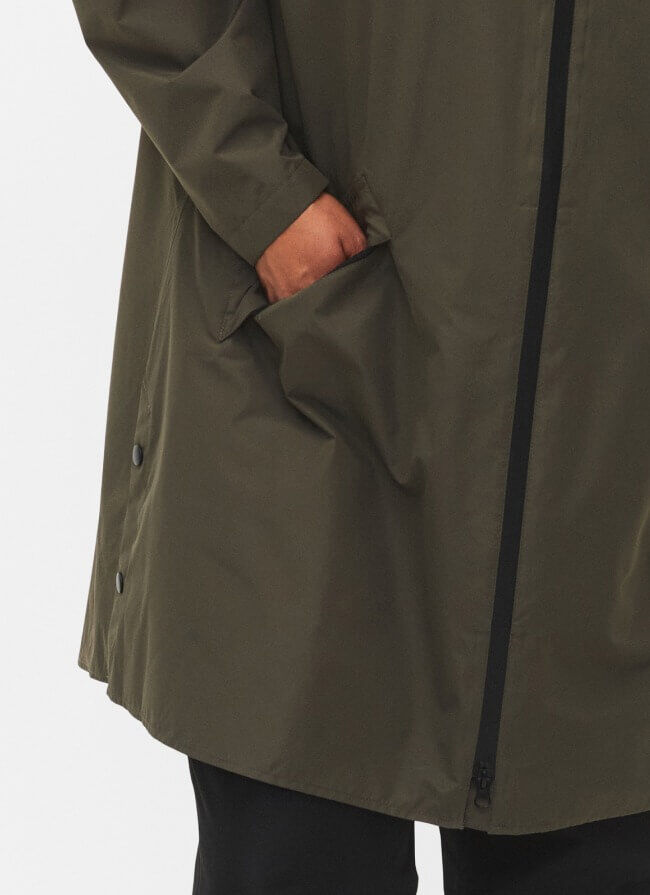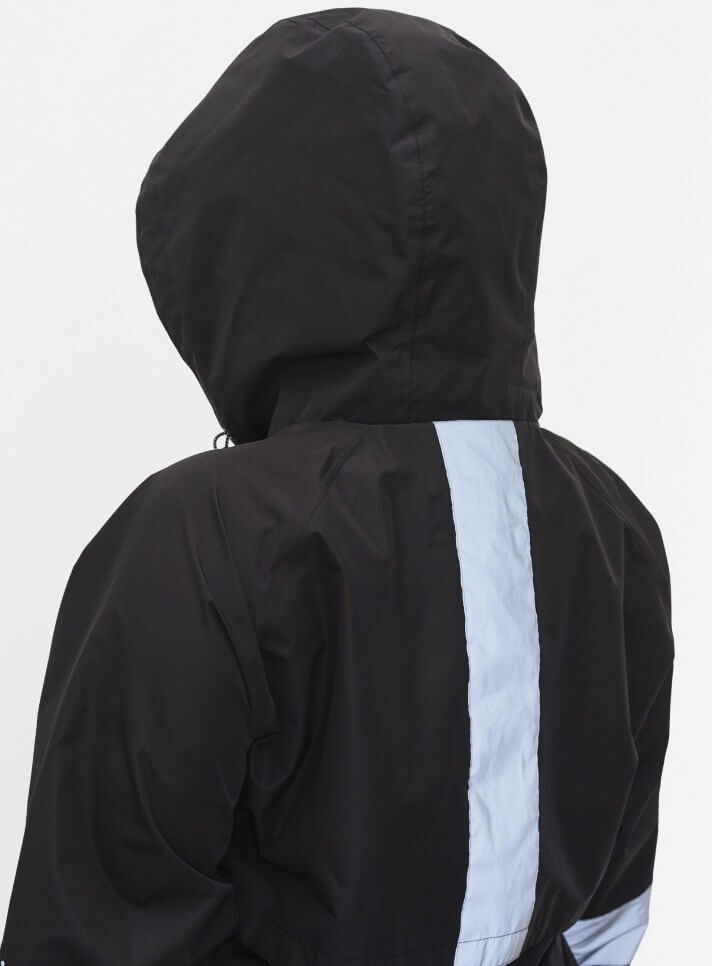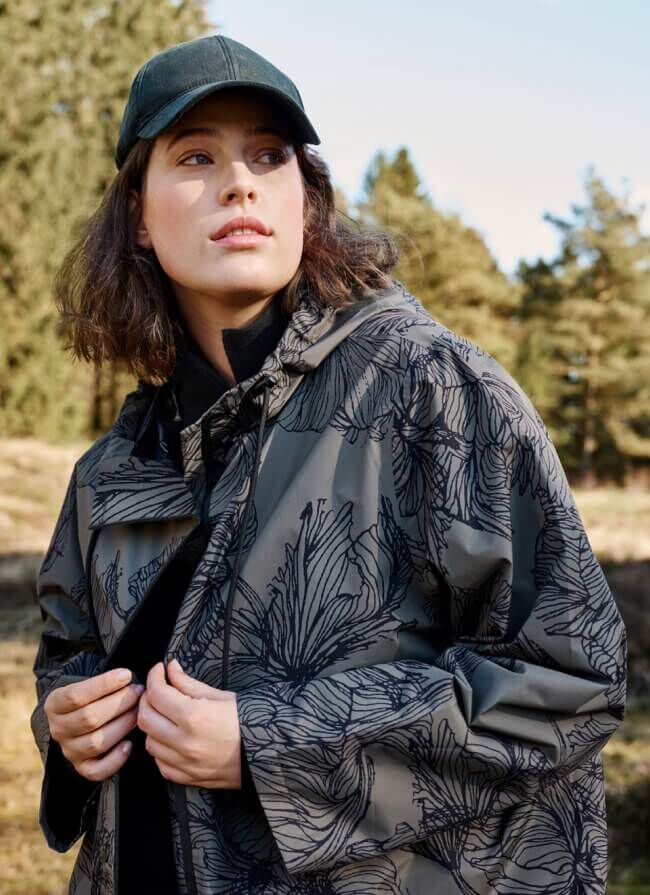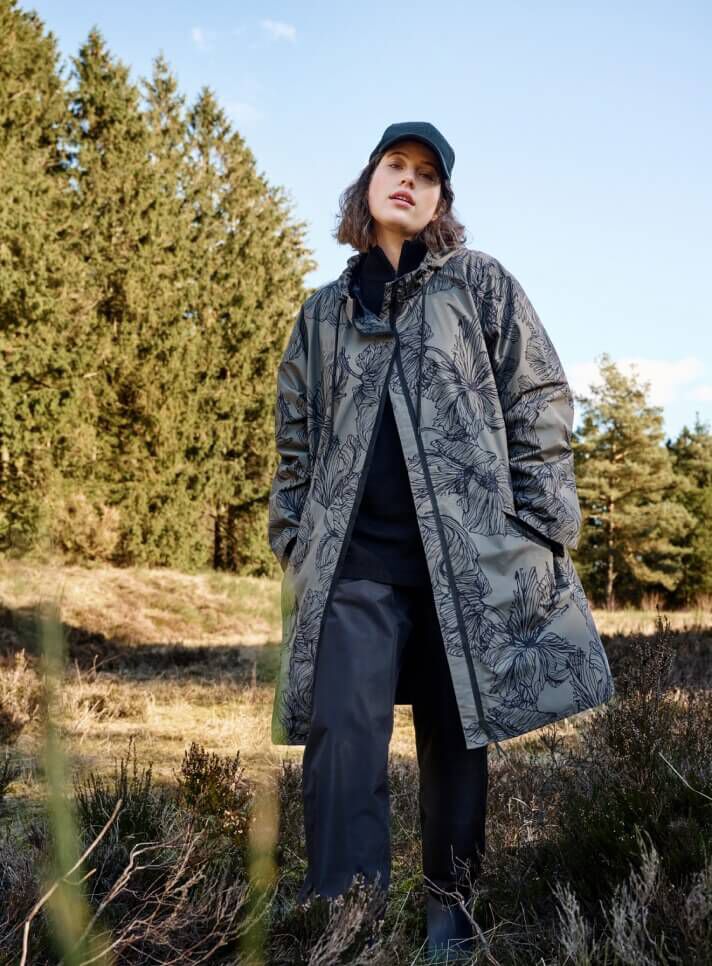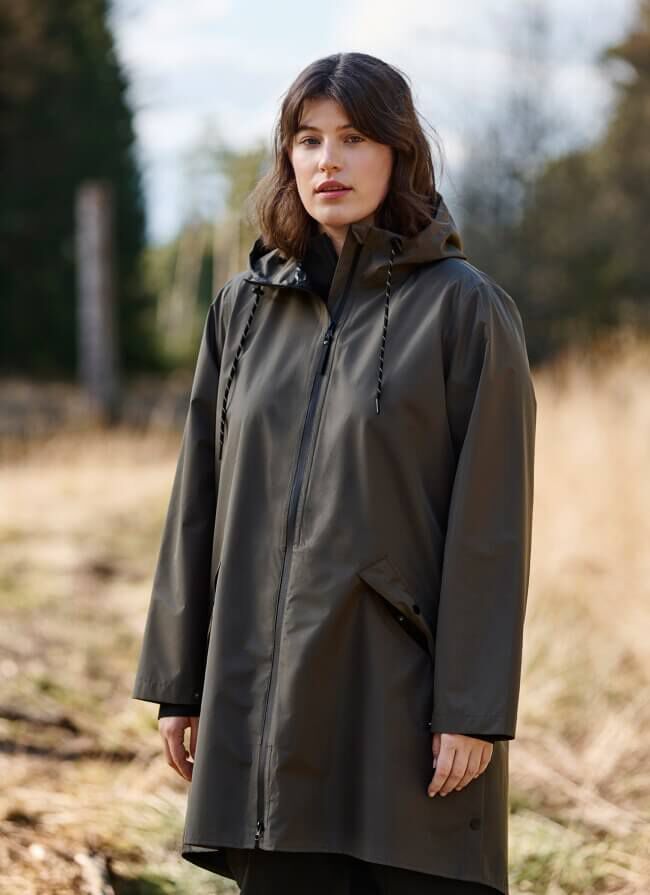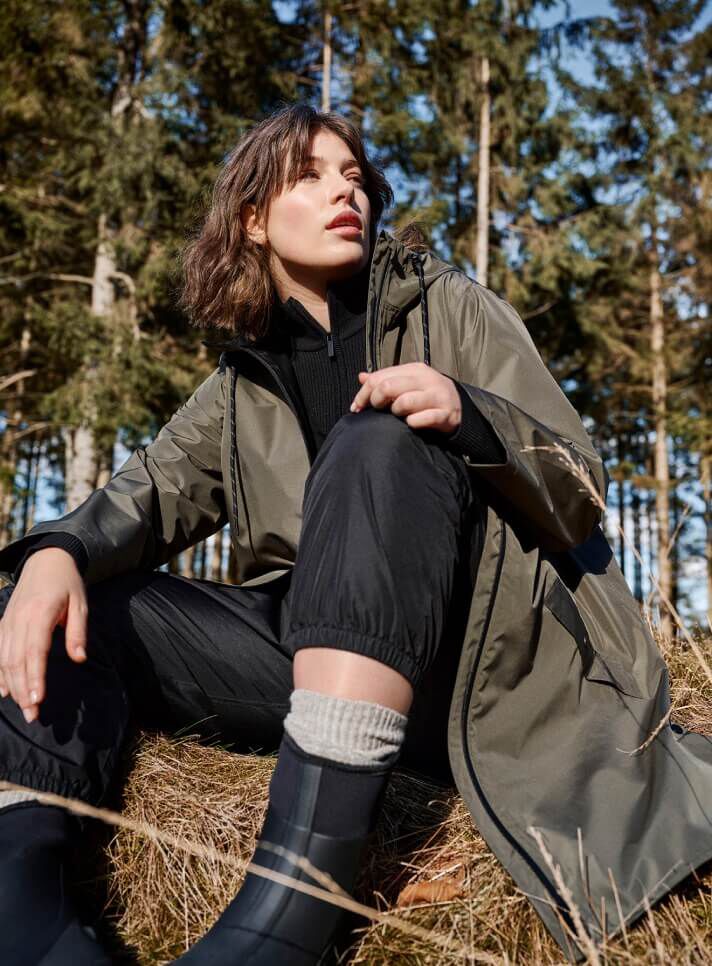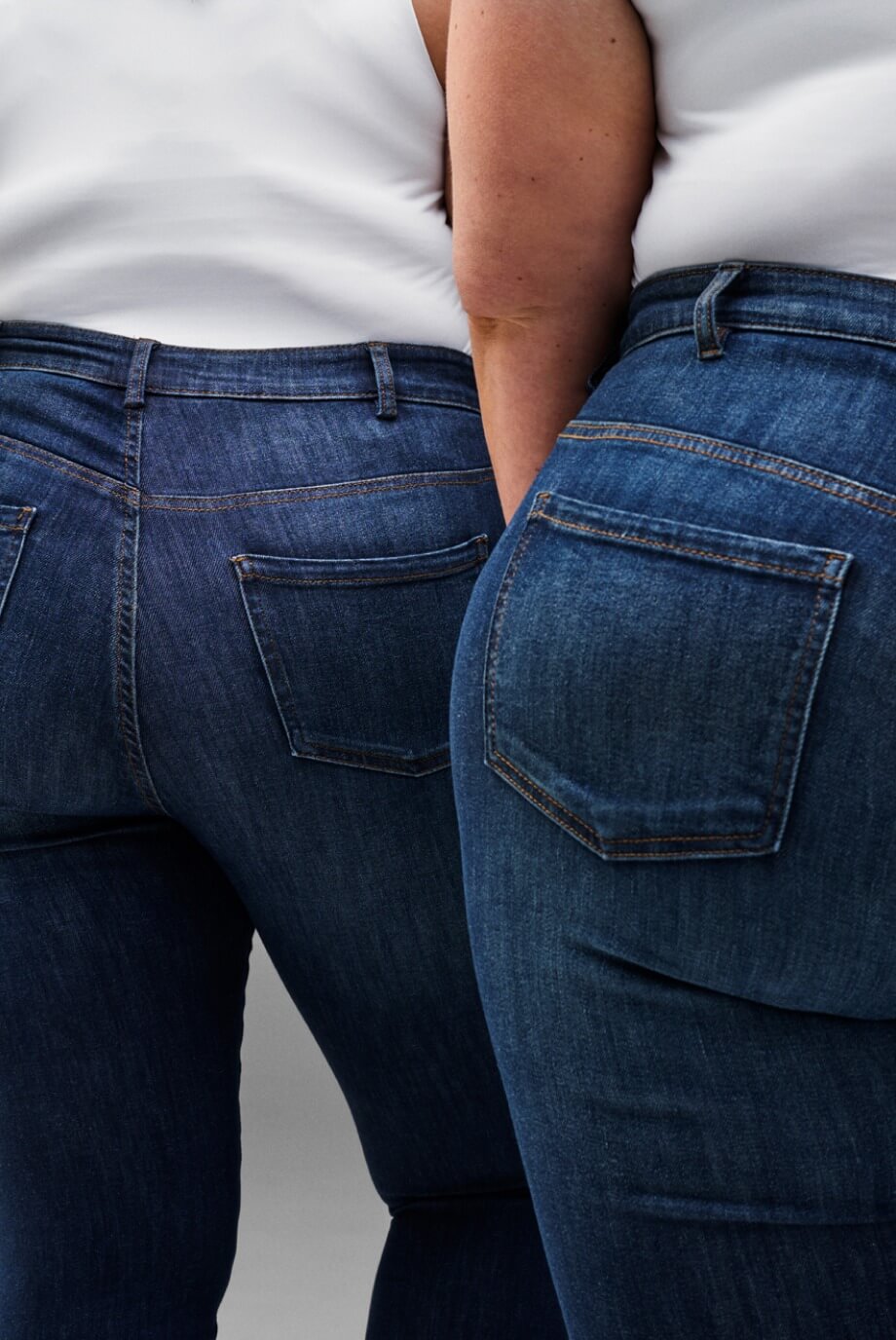
How to choose the right rainwear
Which rainwear should I choose? You may have asked yourself this question multiple times. But the answer depends on several factors. Are you going to be physically active? How much is it raining? And what fit do you prefer? It may seem a bit overwhelming to find the best women's rainwear, so we're here to help you become more knowledgeable about everything from types of rainwear and features to maintenance and materials.
Different Types of Rainwear
There are different forms of rainwear, and depending on what you're doing and how long you'll be out in the rain, it's good to know the different types so you can best utilize their various functions.
Traditional Rain Jackets
The traditional rain jacket is often relatively long and comes with a zipper and hood. It resembles a regular jacket but is made of different material and may also have some other features. This type of rain jacket can be found in several different colors and fits, but it usually fits closer to the body than a rain poncho. The rain jacket is both timeless and functional, making it good for everything from hiking in the woods to daily errands.
Rain Ponchos
With a rain poncho, there's plenty of room for movement. The loose and spacious fit makes it a good choice if you're going to be active in the rain. It's easy and quick to put on, and it often doesn't take up more space than you can carry in your bag. A rain poncho is simpler than a traditional rain jacket and therefore typically doesn't have a lot of pockets, zippers, and features. So if you need some light rainwear that you can easily put over your clothes (and maybe even a small backpack), the rain poncho is the obvious choice.
Rain Pants
If you want to be sure to stay completely dry, a good rain jacket or rain poncho is not enough. You'll also need a pair of rain pants. They are easy to wear over your regular clothes and keep your legs dry and protected. Especially if you're going to cycle, hike, or just be in the rain for an extended period, a pair of rain pants are indispensable.
Know Your Needs
To best choose the right rainwear, it's a good idea to consider what you'll be doing, what the weather conditions are, and what features you need. All these factors can influence what you should go for.
Activity Level
Are you just quickly running an errand, or are you going on a longer outdoor adventure? This will likely influence the features you need in your rainwear.
Everyday Use
There can be many everyday situations where you may need good rainwear. Whether you're cycling to work or quickly going shopping, comfort and accessibility are important. You should easily be able to put on the rainwear, and it should at least have basic features like a good hood, taped seams, and room for movement. It would also be advantageous if your rainwear matches your everyday clothes, so you don't have to think too much about wearing practical outerwear that might disrupt your look.
Outdoor Activities
If you're going to be outdoors for an extended period or be active while you're out, you'll most likely need more features. If you're often out in wet weather, you primarily need durable rainwear that can withstand all kinds of weather. Whether you're hiking, mountain biking, or doing something else, your rainwear should be durable, offer good protection, and withstand harsh weather.
You may also need good pockets to keep your small items dry, a large adjustable hood, and rain pants with room for movement. Last but not least, it should be breathable rainwear for women - when you're active, you need to be able to release some heat.
Season and Weather Conditions
The season and other weather conditions also matter when choosing rainwear. It could be a warm summer rain you're going out in, or perhaps you need to prepare for a wet and windy autumn day.
Spring and Summer
Even if it's warm, it can still rain - and sometimes even more so. Therefore, it's good to have a breathable rain jacket for women, so you can stay dry without getting too hot. Some rain jackets have ventilation openings on the back or under the arms, which help the body release heat. You can also find rainwear made of lighter material like polyester. If treated to be water-repellent, it's suitable for warmer weather because it's so light.
Autumn and Winter
For colder months, you need well-insulated rainwear. It may need to withstand both rain and sleet. Make sure to choose rainwear with higher water column pressure to ensure you stay dry. As the weather gets colder, you can also switch to rainwear with fleece. It provides good comfort while reducing the risk of getting cold. Alternatively, you can use a softshell jacket instead of a rain jacket during this period. It offers good protection against harsh weather while being functional and breathable.
Practical Features
Depending on when you'll be using your rainwear and what you'll be doing, you may need different practical features. We'll go through some of the most common features below.
Pockets and Zippers
When you're out in the rain, it's not just you but also your belongings that need to stay dry. Therefore, it's important that both zippers and pockets are waterproof. Look for taped seams in the zippers so that rain doesn't seep in through the small stitch holes. Also, make sure to have good pockets that suit your needs. You may need large pockets where you can store everything from a pair of gloves to a pair of headphones. Alternatively, you might prefer smaller inner pockets for your phone and keys for added security.
Hoods and Closures
It's a good idea to pay attention to both the hood and closures on your rainwear. The primary function of closures is to keep the rain out, but it varies whether they are zippers, buttons, Velcro, or something else. This depends on the design of the rainwear and your needs.
Your rain jacket should also have a hood to protect your head from the rain. Some jackets have a detachable hood, while others are fixed. The more adjustment options it has, the better you can tailor it to keep you dry. If you're going to wear a bike helmet or hat under the hood, make sure it's large enough.
Colors and Reflectors
When it rains heavily, visibility can sometimes be reduced - especially early and late in the day. Therefore, it may be a good idea for both your own and others' safety to choose rainwear with reflectors. This increases safety and visibility, making it easier for others to spot you.
Reflectors are one way to be seen, but another is colors. Much rainwear comes in dark colors, but if you like colorful outfits, it's obvious to add colors to your rainwear as well. It makes you more visible, it's trendy, and who knows—maybe it can also spread smiles and good vibes in the wet (and for some, gloomy) weather.
What is Rainwear Made Of?
Rainwear is usually made of materials specifically developed to be waterproof or water-resistant while also being breathable and comfortable. For example, it could be nylon or polyester treated with a water-repellent coating. Often, materials and functions are combined to achieve the best result.
Common Materials in Rainwear:
- Polyester: A synthetic fabric often used as the outer material in rainwear. It can be treated with a water-repellent coating or membrane to prevent water from penetrating.
- Nylon: Another synthetic material often used as the outer material in rainwear. It is known for its durability and water-resistant properties.
- Polyurethane (PU): PU coatings are often used as waterproof barriers on fabrics like polyester or nylon. They provide water-resistant properties and breathability.
- Membranes: Materials like Gore-Tex, eVent, and other waterproof membranes are used in rainwear to combine waterproofing with breathability. They allow water vapor to escape while preventing water from entering.
- Vinyl: Vinyl coatings can also be used to create waterproof rainwear. This material may be more plastic-like and less breathable than some of the other options.
- Coated Nylon or Polyester: These materials are coated with a waterproof or water-resistant compound to protect against rain. They can vary in thickness and breathability.
Understanding Waterproofing and Breathability
The two terms most often discussed when it comes to rainwear are waterproofing and breathability. But it can be difficult to know what to look for if you're not used to considering these factors. In the sections below, you'll get an explanation of what they mean and what to keep an eye on.
ALSO READ: Guide to Breathability and Waterproofing
Hydrostatic Head in Rainwear
The waterproofing of rainwear is assessed based on a technical measurement of hydrostatic head. The manufacturer tests it by placing a column of water on top of the fabric. The hydrostatic head is read by measuring in millimeters how much water can be in the column before it starts to penetrate the material. In this way, the result is obtained. The higher the hydrostatic head, the more water-resistant the material is.
How Waterproof Should Rainwear Be?
The weather conditions and what you plan to do help define how waterproof your rainwear should be. If there's just a light drizzle when you're going into town, your rainwear doesn't need to be as waterproof as if you're going on a long hike in pouring rain.
You can use the levels below to help assess how waterproof your rainwear should be:
- 1.000-5.000 mm: For light rain and general use in urban environments, rainwear with this hydrostatic head is usually sufficient. This level of waterproofing can protect against light rain showers and slight moisture. This could be light rain jackets or some training jackets that fall within this range.
- 5.000-10.000 mm: If you plan to be outside for an extended period or participate in activities like hiking, cycling, or camping, you should consider rainwear with a hydrostatic head of at least 5,000 mm to 10,000 mm. This level will provide better protection against moderate rain and more challenging weather conditions. Here you will most often find softshell jackets and some outdoor pants.
- 10.000-20.000 mm: If you find yourself in areas with frequent heavy rain or extreme weather conditions like mountains or rainforests, rainwear with this hydrostatic head is ideal. This level of waterproofing provides good protection against heavy rain and demanding environments. This could be outerwear like shell jackets or ski jackets.
- Over 20.000 mm: Professional outdoor workers like mountaineers, rescue workers, or sailors may need extraordinarily waterproof rainwear with extremely high hydrostatic heads that suit their specific requirements and risk factors.
Breathable Rainwear for Women
Your rainwear should keep water out, but it should also allow body heat to escape through the fabric. This can be a difficult balance because too high breathability can affect waterproofing, while too low breathability makes the fabric feel moist or clammy on the skin.
Breathability in rainwear is measured by assessing how well moisture such as sweat can evaporate from the body through the fabric. The amount of water vapor that can pass through a square meter of fabric over a period is denoted as "grams per square meter per 24 hours" (g/m2/24h). The ranges below can be a guide to how breathable your rainwear should be.
- Under 5.000 g/m2/24h: Low breathability. This means the fabric has limited ability to let moisture pass through, which can lead to increased sweating and discomfort during activities.
- 5.000-10.000 g/m2/24h: Moderate breathability. This level of breathability provides a reasonable balance between comfort and protection against moisture.
- 10.000-20.000 g/m2/24h: High breathability. This level of breathability effectively allows moisture to pass through the fabric and is suitable for more intense activities.
- Over 20.000 g/m2/24h: Very high breathability. This level of breathability is ideal for intense physical activity and ensures optimal comfort under sweaty conditions.
Size and Fit
As a starting point, you can simply choose rainwear in your regular clothing size. However, it's always practical to opt for a relatively loose fit. This way, you have the option to wear multiple layers, such as a sweater and jeans, under the rainwear. At the same time, there's more room for movement if you're going to be active. Looser rainwear also provides better comfort due to improved air circulation. But it's always a personal preference whether you prefer one fit over the other. Go with what makes you feel most comfortable.
Maintenance and Care of Rainwear
If you want to keep your rainwear for many seasons, you need to take care of it to maintain its waterproof and functional properties.
Make sure to wash it according to the instructions with a mild soap and avoid fabric softener. After washing, do not tumble dry it, and avoid drying it in direct sunlight. If you don't dry it correctly, you risk damaging the coatings and breaking down the materials over time.
It may seem strange to talk about impregnating rainwear since it should already be treated. However, over time, the coatings and membranes may lose their effectiveness, so it's necessary to refresh the waterproofing by impregnating it.
Choose the Best Rainwear for You
When you ask the question, "Which rainwear should I choose?", it may seem overwhelming to find the answer. But what you need to consider is: What will I be doing in the rain, and what's the weather like otherwise? This way, you can narrow down the features you need. Individual preferences like fit and style also come into play. Once that's sorted, you can hunt for the women's rainwear that suits you best.
Alternative Waterproof Outerwear
The best choice on rainy days is undoubtedly rainwear, but if you want alternatives, there are a few other models to consider.
- Ski Jacket: A ski jacket is designed to handle challenging weather conditions. It's developed with a focus on technical features and materials that ensure comfort, protection, and flexibility. It's warmer than a rain jacket, typically has better breathability, and protects against heavy rain and snow.
- Softshell Jacket: The softshell jacket is good if you're doing outdoor activities where you need freedom of movement but still want to be protected from the weather. It's a practical jacket that usually has good breathability. It doesn't have the same level of waterproofing as a rain jacket but can protect against light rain.
- Winter Jackets: Most winter jackets are water-resistant or waterproof because they're designed to protect you in the cold winter months. They are typically thicker and heavier than a rain jacket and well-insulated. The degree of waterproofing varies, so be aware of what you'll be using the jacket for.
Shell Jacket or Rain Jacket?
In your search for rainwear, you may come across the shell jacket, and to help you best determine whether you need a rain jacket or a shell jacket, here is a description of the two jackets.
- Shell Jacket: The shell jacket is designed to protect against wind, water, and snow. It is suitable for outdoor activities because it can handle challenging weather conditions while being durable and breathable. The downside of the shell jacket is that it is typically heavier to wear because it has so many functions.
- Rain Jacket: The rain jacket is specifically designed to protect against rain. It is made of a lighter material, making it suitable for everyday use. It is also easy to carry and put on over your regular clothes.























